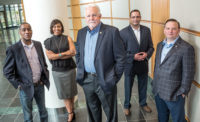Disclaimer: The author’s name has been changed to protect the privacy of the paranoid security expert.
A lack of skilled staff remains the top security concern for organizations, according to the State of Security Operations Report. One way organizations can mitigate this challenge is to hire security consultants. These professionals work closely with their clients to help solve issues, implement best practices, and provide guidance. While there are no two days that are alike, here’s my typical day in the life as a professional security consultant:
6:00 A.M.
Wake up to my phone’s alarm going off. Find my way across the dark hotel room towards my phone, which I always leave far from my bed to prevent any snoozing. Check emails, social media and text messages, and make sure there aren't any security emergencies that need my attention right away. I try to avoid using the hotel Wi-Fi, as these are typically public networks with little security, but when I do, I always make sure to use a VPN.
6:15 A.M.
Head to the hotel's fitness center and turn on “Mr. Robot.” Being on the road and dining out for every meal can add pounds quickly, so it’s important to eat healthy and exercise while traveling.
7:30 A.M.
Shower, get ready and grab a double shot of espresso to help get my engines started. Most client engagements only last a week at a time, and I need to perform my best.
8:30 A.M.
Drive to client site in my rental car.
9:00 A.M.
Once I arrive, I check in at the front security desk, show ID, sign-in, and take care of any physical security requirements. Situations vary from being escorted around the office, given a visitor’s badge to wear, or getting my own photo ID badge that I can use to come and go as I please.
9:15 A.M.
Meet the client staff and host a kick-off meeting. Review the statement of work together to fully understand the client's expectations and security challenges.
10:00 A.M.
Get down to business. Depending on the client, I may be able to connect to their environment with my own laptop, use a workstation they provide, or instruct the client to do the work through my guidance over a shared screen, projector or remote screen-sharing session. Clients all have varying degrees of security measures.
11:00 A.M.
I’m deep into my work now. I take detailed notes of what I need to do, any new tasks that are identified, and track what I've done. Keeping good notes makes it easier to author an engagement report at the end of the week, summarizing what was accomplished, recommendations for the client, and proposing next steps. It's crucial to communicate any risks to the client and management as soon as you identify them, and escalate or adjust your strategy as required.
12:00 P.M.
Grab lunch.
1:00 P.M.
Grab another coffee if I need one, and work on the task at hand.
2:00 P.M.
I've probably encountered at least one technical issue now that I need to troubleshoot. There’s not a single day that goes by where I don't learn something new. To investigate the issue, I troubleshoot what may be causing it, review log files, try to reproduce the issue, and utilize resources I have available to me. These could include reading product documentation, searching through our internal forum and knowledge base, or asking colleagues for their perspective on the issue. Even though I travel by myself most of the time, I have a strong team behind me for support. It's important to weigh the severity of the issue against the time you're willing to invest in solving it, so you stay on target with deliverables in the time you have scheduled. With enough troubleshooting you can crack almost all cases.
3:00 P.M.
After resolving the issue, I'll communicate to the client the root cause, and how I was able to troubleshoot and resolve it. Clients really appreciate the knowledge transfer, and the step-by-step teaching enables them to troubleshoot similar issues in the future.
5:00 P.M.
Wrap up the day and close out with the client, discussing accomplishments and tomorrow’s activities. We try to stick to a maximum of eight hours of billable client work per day to prevent burnout, but sometimes duty calls for a late night of troubleshooting. Either way, it's my call to make, and this isn't a job where you're expected to stay late just to keep up appearances as a “team player.” You work hard and give it your very best during eight hours of the work day, then decompress and recharge, and resume the next day. When I get back to the hotel, I always latch the door and engage the deadbolt – you can never be too safe when it comes to security.






